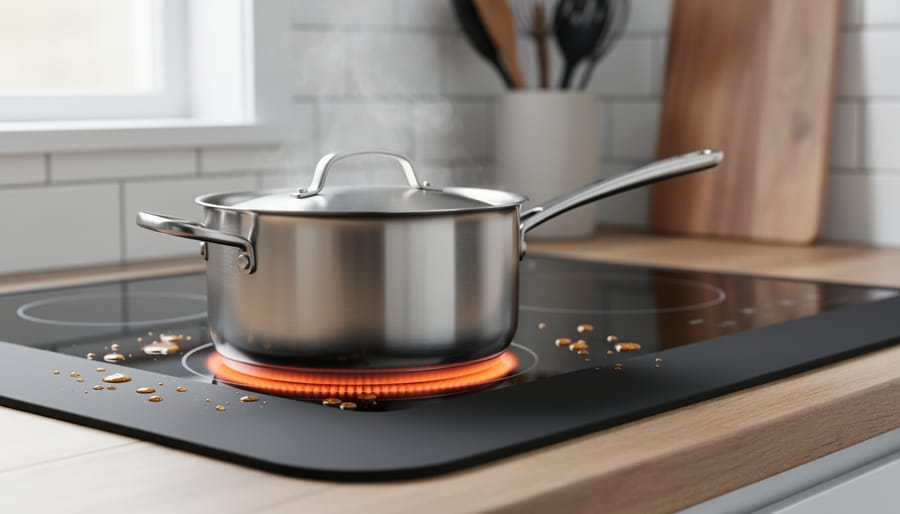The bathroom is often considered a purely functional space, designed for quick showers, brushing teeth, and the usual morning routines. But what if this utilitarian room could transform into a haven of relaxation and warmth? Imagine soaking in a luxurious bathtub with the glow of a flickering fire nearby.
It’s a scene right out of a high-end spa, and increasingly, homeowners are looking to recreate this ambience by adding fireplaces to their bathrooms. But can it actually be done? The short answer is yes, but there are several considerations to keep in mind. Let’s explore the possibilities and practicalities of installing a fireplace in your bathroom.
Why Add a Fireplace to Your Bathroom?
Before diving into the logistics of installation, it’s important to understand why you might want to add a fireplace to your bathroom in the first place. Modern design trends are moving towards creating spa-like sanctuaries within the home, where comfort and luxury are at the forefront. A fireplace serves as a focal point that enhances the ambience of your bathroom, making it a place not just for hygiene but for relaxation and self-care.
Ambience: The primary appeal of a bathroom fireplace is the ambience it creates. The soft, warm glow of a fire adds a sense of calm and serenity, turning an ordinary bath into a tranquil retreat.
Warmth: On chilly mornings or after a long day, the warmth provided by a fireplace can make the bathroom experience more comfortable. This added heat can be particularly beneficial in large or open-plan bathrooms, where it may take longer for a central heating system to warm the space.
Luxury: There’s an undeniable element of luxury associated with having a fireplace in the bathroom. It’s a feature often found in upscale hotels and spas, and bringing this touch of sophistication into your own home can elevate your everyday experience.
Types of Fireplaces Suitable for Bathrooms
Not every fireplace is suitable for the moist and often compact environment of a bathroom. However, there are several types of fireplaces that are well-suited for bathroom installation, each with its own benefits and considerations.
- Electric Fireplaces: Electric fireplaces are arguably the most versatile and convenient option for bathrooms. They don’t require ventilation, making them easy to install almost anywhere. They also offer a wide range of styles and sizes, allowing you to choose a model that fits seamlessly with your bathroom’s design.
Pros: Easy installation, no need for ventilation, a wide range of styles, low maintenance.
Cons: Lacks the authenticity of real flames and has limited heat output compared to gas fireplaces.
Electric fireplaces also offer modern features like remote control, adjustable heat settings, and even flame colour customisation, which can add to the relaxing atmosphere. - Gas Fireplaces: Gas fireplaces provide the beauty of real flames without the hassle of burning wood. They offer a good balance between heat output and installation complexity. However, they do require proper ventilation, which means you’ll need to install a vent or chimney, adding to the cost and complexity.
Pros: Real flames, consistent heat output, relatively low maintenance.
Cons: It requires ventilation, professional installation is needed, and it has a higher cost.
Gas fireplaces can be fueled by natural gas or propane, and many models are designed to complement modern bathroom designs, featuring sleek lines and minimalist aesthetics. - Ethanol Fireplaces: Ethanol fireplaces are a modern, eco-friendly option that’s gaining popularity. These fireplaces burn bioethanol fuel, which produces real flames without the need for a chimney or vent. They are typically small and portable, making them ideal for bathrooms with limited space.
Pros: Real flames, no need for ventilation, portable, eco-friendly.
Cons: Requires regular refuelling, less heat output, and ongoing fuel costs.
Ethanol fireplaces are available in a variety of styles, from tabletop models to wall-mounted units, allowing you to choose one that suits your bathroom’s size and style.
Key Considerations Before Adding a Fireplace
While the idea of a bathroom fireplace is undoubtedly appealing, there are several important factors to consider before moving forward with the installation.
- Space and Layout: The first thing to consider is whether your bathroom has enough space for a fireplace. Bathrooms are typically smaller rooms, so adding a fireplace could make the space feel cramped if not carefully planned. Consider the layout of your bathroom and whether there’s a suitable spot for a fireplace that won’t interfere with movement or other fixtures.
If you’re in the process of renovating or building a new bathroom, you have more flexibility to design the space around the fireplace. For existing bathrooms, you’ll need to work within the constraints of the current layout, which may limit your options. - Ventilation: Ventilation is a crucial factor, especially if you’re considering a gas or wood-burning fireplace. Proper ventilation is necessary to ensure the safe operation of the fireplace and to prevent the buildup of harmful gases like carbon monoxide.
Installing a vent or chimney may not be feasible in all homes, particularly in bathrooms that are not located on an exterior wall. In such cases, an electric or ethanol fireplace may be a better option. - Safety: Safety should be a top priority when adding a fireplace to your bathroom. Water and electricity don’t mix well, so if you’re installing an electric fireplace, ensure it’s placed far enough from any water sources to avoid accidents.
For gas fireplaces, it’s essential to ensure proper installation and maintenance to prevent gas leaks. It’s also important to consider the materials used in and around the fireplace. Choose heat-resistant materials like tile, stone, or tempered glass to prevent heat damage. - Moisture and Humidity: Bathrooms are naturally humid environments, which can affect the longevity and performance of your fireplace. Wood-burning fireplaces, in particular, are susceptible to moisture damage, which can cause the wood to rot or warp over time.
To combat this, choose materials that can withstand humidity, such as stainless steel or tempered glass. Regular maintenance, such as cleaning and inspecting the fireplace, will also help ensure it remains in good condition. - Budget: Installing a fireplace in your bathroom can be a significant investment. The cost will vary depending on the type of fireplace, the complexity of the installation, and any additional construction work required.
Electric fireplaces are generally the most affordable option, with prices ranging from a few hundred to a few thousand dollars, depending on the model. Gas fireplaces are more expensive, particularly when you factor in the cost of venting and professional installation. Ethanol fireplaces fall somewhere in between, but you’ll need to budget for ongoing fuel costs.
Installation Process
Once you’ve chosen the type of fireplace that’s best suited for your bathroom, the installation process begins. Here’s a step-by-step overview of what to expect:
- Consult a Professional: Even if you’re opting for a relatively simple electric or ethanol fireplace, it’s a good idea to consult with a professional bathroom reno expert. They can help you determine the best placement for the fireplace, ensure it meets local building codes, and handle any necessary electrical or gas work.
- Prepare the Space: Depending on the type of fireplace, you may need to make some modifications to your bathroom. This could involve installing a new electrical outlet, adding a vent or chimney, or reinforcing the walls and floor to support the weight of the fireplace.
You’ll also need to consider the location of the fireplace in relation to other bathroom fixtures. It’s important to place the fireplace in a spot where it can be safely enjoyed without interfering with the shower, tub, or sink. - Install the Fireplace: The installation process will vary depending on the type of fireplace you’ve chosen. Electric fireplaces are typically the easiest to install, often requiring little more than plugging in and mounting to the wall. Gas fireplaces require more complex installation, including connecting to a gas line and installing proper ventilation. Ethanol fireplaces are relatively simple but require a sturdy, heat-resistant surface for placement.
- Add Finishing Touches: Once the fireplace is installed, you can add finishing touches to integrate it seamlessly into your bathroom’s design. Consider adding a decorative surround, such as tile or stone, to enhance the fireplace’s aesthetic appeal. You might also want to include built-in shelving or a mantel to display candles, plants, or other decor items that complement the fireplace.
Maintenance and Care
Maintaining your bathroom fireplace is crucial to ensure its longevity and safe operation. The maintenance required will depend on the type of fireplace you’ve installed.
Electric Fireplaces: These require minimal maintenance, usually limited to occasional dusting and cleaning of the glass. It’s also a good idea to check the electrical connections periodically to ensure everything is functioning properly.
Gas Fireplaces: Gas fireplaces should be serviced annually by a professional to ensure they’re operating safely and efficiently. This includes checking the gas line, inspecting the vent or chimney, and cleaning the fireplace’s interior.
Ethanol Fireplaces: Ethanol fireplaces require regular refuelling, and it’s important to use high-quality bioethanol fuel to ensure clean burning. The fireplace’s burner should be cleaned regularly to prevent the buildup of soot or residue.
Conclusion
Adding a fireplace to your bathroom is a luxurious addition that can transform the space into a cosy, spa-like retreat. While it requires careful planning and consideration, the end result can be a stunning feature that adds both warmth and ambience to your home. Whether you choose an electric, gas, or ethanol fireplace, the key is to ensure proper installation, safety, and maintenance.
Disclaimer: Always consult with a licensed professional before proceeding with any installation to ensure your bathroom fireplace complies with local building codes and safety standards. Proper installation is essential to prevent potential hazards and to enjoy your bathroom fireplace safely for years.






